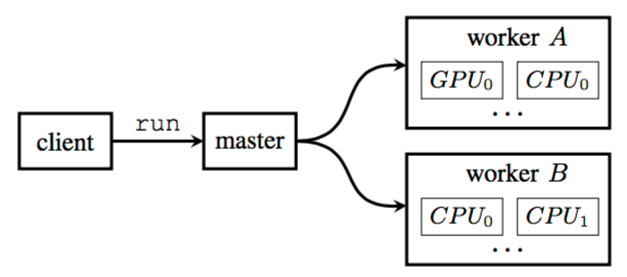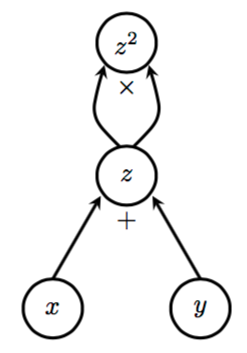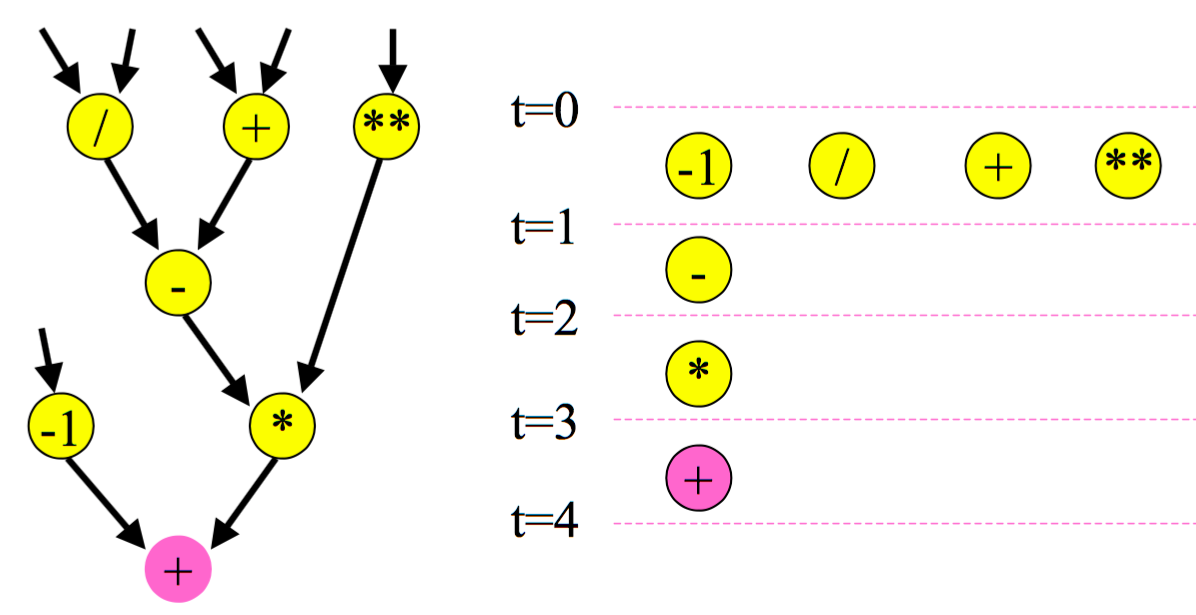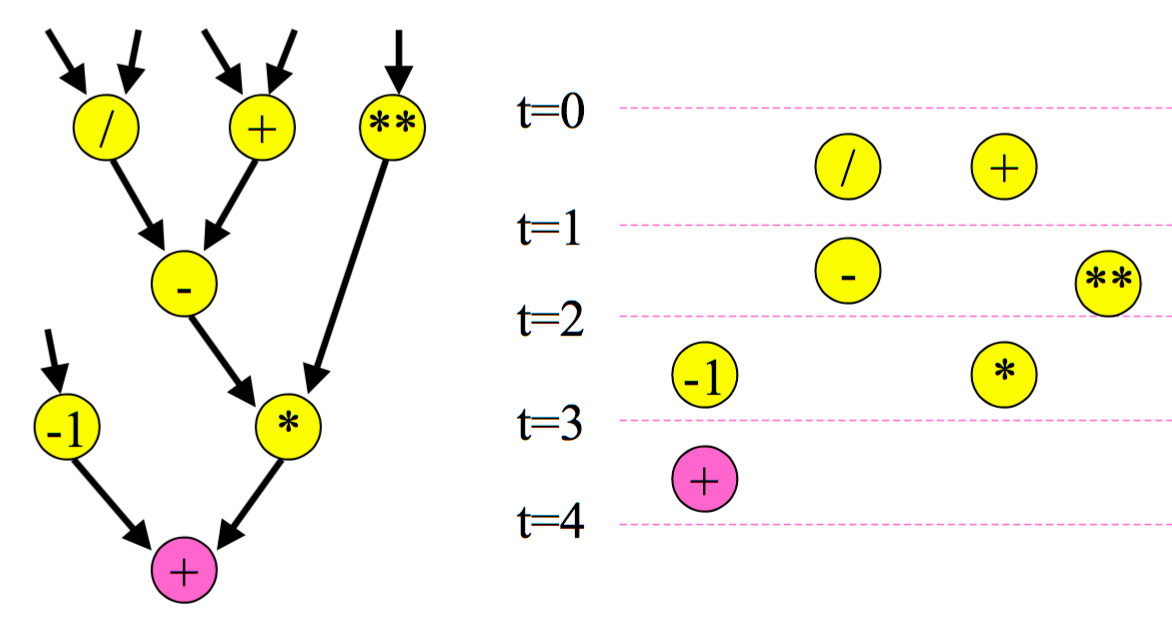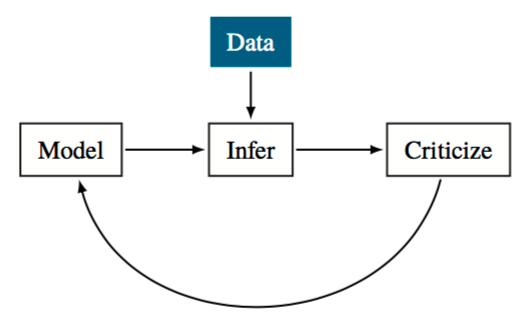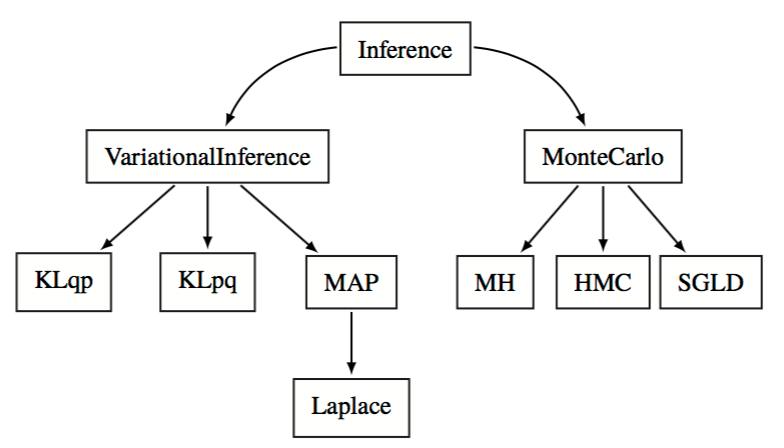TensorFlow and Edward¶
Packages¶
References¶
TensorFlow¶
A Python/C++/Go framework for compiling and executing mathematical expressions
First released by Google in 2015
Based on Data Flow Graphs
Widely used to implement Deep Neural Networks (DNN)
Edward uses TensorFlow to implement a Probabilistic Programming Language (PPL)
Can distribute computation to multiple computers, each of which potentially has multiple CPU, GPU or TPU devices.
Execution model¶
Placement algorithm¶
Kernel on device?
Size of input and output tensors
Expected execution time
Heuristic for cross-device transmission time
Optimization 1: Common subgraph elimination¶
Before |
After |
|---|---|
|
|
Optimization 2: As late as possible (ALAP) scheduling¶
ASAP |
ALAP |
|---|---|
|
|
Lossy compression for cross-device transmission
Automatic differentiation¶
Symbol-to-symbol calculation of gradient
Used for back-propagation in neural networks
Used for gradient based optimization, HMC etc in Edward
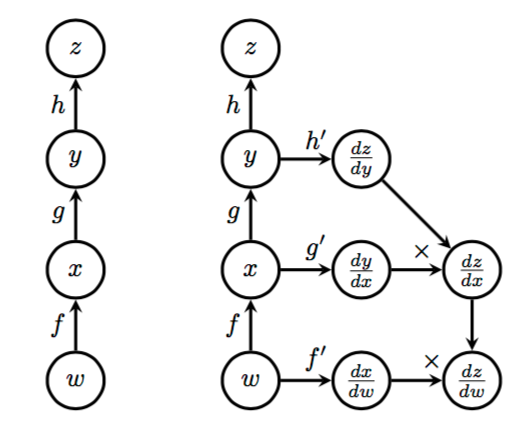
Chain rule¶
Other features¶
Control flow (if and while) - enable recursion and cycles
Checkpoints
saverestore
TensorBoard visualization
Graphs
Scalar summaries (e.g. evaluation metrics)
Histogram summaries (e.g. weight distribution)
Abstraction layers¶
Deep Neural Networks
contrib.learntflearntf-slimkeras
Probabilistic Programming Language
edward
TensorFlow Examples¶
Hello world¶
In [1]:
import tensorflow as tf
h = tf.constant('Hello')
w = tf.constant(' world!')
hw = h + w
with tf.Session() as s:
ans = s.run(hw)
In [2]:
hw
Out[2]:
<tf.Tensor 'add:0' shape=() dtype=string>
In [3]:
ans
Out[3]:
b'Hello world!'
Arithmetic on data flow graphs¶
In [4]:
a = tf.constant(5)
b = tf.constant(2)
c = tf.constant(3)
d = tf.multiply(a, b)
e = tf.add(b, c)
f = tf.subtract(d, e)
with tf.Session() as s:
fetches = [a, b, c, d, e, f]
ans = s.run(fetches)
ans
Out[4]:
[5, 2, 3, 10, 5, 5]
Using operators¶
In [5]:
a = tf.constant(5)
b = tf.constant(2)
c = tf.constant(3)
d = a * b
e = b + c
f = d - e
with tf.Session() as s:
fetrches = [a,b,c,d,e,f]
ans = s.run(fetches)
ans
Out[5]:
[5, 2, 3, 10, 5, 5]
Placeholders¶
In [6]:
import numpy as np
In [7]:
x_data = np.random.randn(5, 10)
w_data = np.random.randn(10, 1)
x = tf.placeholder('float32', (5, 10))
w = tf.placeholder('float32', (10, 1))
b = tf.fill((5,1), -1.0)
xwb = tf.matmul(x, w) + b
v = tf.reduce_max(xwb)
with tf.Session() as s:
ans = s.run(v, feed_dict={x: x_data, w: w_data})
ans
Out[7]:
9.055994
Linear regreession¶
In [8]:
n, p = 1000, 3
α = -1.0
β = np.reshape([0.5, 0.2, 1.0], (3,1))
x_data = np.random.randn(n, p)
y = α + x_data @ β + np.random.randn(n, 1)
In [ ]:
x = tf.placeholder('float32', [None, p])
y_true = tf.placeholder('float32', [None, 1])
a = tf.Variable(0.0, dtype='float32')
b = tf.Variable(np.zeros((3,1), dtype='float32'))
y_pred = a + tf.matmul(x, b)
ϵ = 0.5
loss = tf.reduce_mean(tf.square(y_true - y_pred))
optimizer = tf.train.GradientDescentOptimizer(learning_rate=ϵ)
train = optimizer.minimize(loss)
init = tf.global_variables_initializer()
In [9]:
steps = 5
with tf.Session() as session:
session.run(init)
for i in range(1, steps):
session.run(train, feed_dict={y_true: y, x: x_data})
if i% 1 == 0:
a_, b_ = session.run([a, b])
print('iter={}'.format(i))
print('a = {}'.format(a_))
print('b = {}'.format(b_.ravel()))
print()
iter=1
a = -0.9617397785186768
b = [ 0.58339775 0.21545935 0.97747314]
iter=2
a = -0.9741984009742737
b = [ 0.57611543 0.22001249 1.00742912]
iter=3
a = -0.9753177762031555
b = [ 0.57605499 0.2206755 1.00737011]
iter=4
a = -0.9753146171569824
b = [ 0.57600915 0.22066851 1.00741804]
MNIST digits classificaiton (canonical toy example)¶
Collection of \(28 \times 28\) pixel images of hand-written digits. Objective is to classify image into one of ten possile classes. State of the art DNN methods can achieve accuracy of approxmately 99.8% accuracy.
Digits¶
Download the data using
input_datafromtutorials.mnistDeclare x, W, y_true and y_pred
Define loss function
Define minimization algorithm
Define evaluation metrics
Start a session to
Run loop for minimization of batches
Run evaluation metric on test data
In [ ]:
from tensorflow.examples.tutorials.mnist import input_data
n, p = 784, 10
steps = 1000
batch_size = 100
alpha = 0.5
data_dir = '/tmp/data'
data = input_data.read_data_sets(data_dir, one_hot=True)
In [ ]:
x = tf.placeholder(tf.float32, [None, n])
W = tf.Variable(tf.zeros([n, p]))
y_true = tf.placeholder(tf.float32, [None, 10])
y_pred = tf.matmul(x, W)
loss = tf.reduce_mean(
tf.nn.softmax_cross_entropy_with_logits(logits=y_pred, labels=y_true))
gd = tf.train.GradientDescentOptimizer(alpha).minimize(loss)
correct_mask = tf.equal(tf.arg_max(y_pred, 1), tf.arg_max(y_true, 1))
accuracy = tf.reduce_mean(tf.cast(correct_mask, tf.float32))
In [10]:
with tf.Session() as s:
s.run(tf.global_variables_initializer())
# train
for i in range(steps):
batch_xs, batch_ys = data.train.next_batch(batch_size)
s.run(gd, feed_dict={x: batch_xs, y_true: batch_ys})
# test
ans = s.run(accuracy, feed_dict={x: data.test.images, y_true: data.test.labels})
In [12]:
ans
Out[12]:
0.91790003
Using the tflearn abstraction layer¶
This just implements logistic regresion. Note that we can get much better perofrmance using DNN, but that is not covered here.
In [13]:
! pip install --quiet tflearn
In [14]:
import tflearn
import tflearn.datasets.mnist as mnist
X, Y, validX, validY = mnist.load_data(one_hot=True)
# Building our neural network
input_layer = tflearn.input_data(shape=[None, 784])
output_layer = tflearn.fully_connected(input_layer, 10, activation='softmax')
# Optimization
sgd = tflearn.SGD(learning_rate=0.5)
net = tflearn.regression(output_layer, optimizer=sgd)
# Training
model = tflearn.DNN(net, tensorboard_verbose=3)
model.fit(X, Y, validation_set=(validX, validY), n_epoch=3)
Training Step: 2579 | total loss: 0.25304 | time: 28.264s
| SGD | epoch: 003 | loss: 0.25304 -- iter: 54976/55000
Training Step: 2580 | total loss: 0.24640 | time: 29.406s
| SGD | epoch: 003 | loss: 0.24640 | val_loss: 0.28411 -- iter: 55000/55000
--
In [15]:
model.evaluate(validX, validY)
Out[15]:
[0.92030000000000001]
Edward¶
Data¶
numpyarrays ortensorflowtensorstnesorflowplaceholderstensorflowdata readers
Model¶
A model is a joint distribution \(p(x, z)\) of data \(x\) and latent variables \(z\)
A random variable has a distribution parametrized by a parameter tensor \(\theta^*\)
Each random variable is associated to a tenor
\[x^* \sim p(x \mid \theta^*)\]Random variables can be combined with other TensorFlow operations
Models are built by composing random variables¶
Beta-Bernoulli Model | :————————-:|  |
| 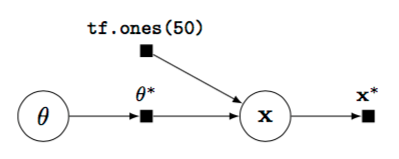 |
|  |
|
Types of models¶
Directed graphical models
Neural networks
Bayesian non-parametric models
Probabilistic programs (stochastic control flow with contingent dependencies)
Inference¶
Posterior inference
\[q(z, \beta; \lambda) \approx p(z, \beta | x)\]Parameter estimation
\[\text{optimize} \; \hat{\theta} \leftarrow p(x; \theta)\]Conditional inference
\[q(\beta)q(z) \approx p(z, \beta \mid x)\]
Criticize¶
Point-based evaluations¶
Evaluation metrics
Classification error
Mean absolute error
Log-likelihood
Posterior predictive checks (PPC)¶
Posterior predictive distribution
\[p(x_\text{new} \mid x) = \int{p(x_\text{new} \mid z) p(z \mid x) dz}\]Procedure
Draw sample from posterior predictive distribution
Calculate test statistic on sample (e.g. mean, max)
Repeat to get distribution of statistic
Compare test statistic on original data to distribution
Edward examples¶
Linear Regreessiion¶
In [16]:
import edward as ed
from edward.models import Normal
Data¶
In [17]:
n, p = 1000, 3
α = -1.0
β = np.reshape([0.5, 0.2, 1.0], (3,1))
# data for training
x_train = np.random.randn(n, p)
y_train = α + x_train @ β + np.random.normal(0, 1, (n,1))
y_train = y_train.ravel()
# data for testing
x_test = np.random.randn(n, p)
y_test = α + x_test @ β + np.random.normal(0, 1, (n,1))
y_test= y_test.ravel()
Model¶
Given data \((x, y)\),
Note that we label the intercept \(\alpha\) as the bias \(b\) and the coefficeints \(\beta\) as weights \(w\) following neural network conventions.
In [18]:
X = tf.placeholder(tf.float32, [n, p])
w = Normal(mu=tf.zeros(p), sigma=tf.ones(p))
b = Normal(mu=tf.zeros(1), sigma=tf.ones(1))
y = Normal(mu=ed.dot(X, w) + b, sigma=tf.ones(n))
Inference¶
We fit a fully factroized variational model by minimizing the Kullback-Leibler divergence.
In [19]:
qw = Normal(mu=tf.Variable(tf.random_normal([p])),
sigma=tf.nn.softplus(tf.Variable(tf.random_normal([p]))))
qb = Normal(mu=tf.Variable(tf.random_normal([1])),
sigma=tf.nn.softplus(tf.Variable(tf.random_normal([1]))))
In [20]:
inference = ed.KLqp({w: qw, b: qb}, data={X: x_train, y: y_train})
inference.run()
1000/1000 [100%] ██████████████████████████████ Elapsed: 7s | Loss: 1438.422
Criticism¶
Find the posterior predictive distrbution.
In [21]:
y_post = ed.copy(y, {w: qw, b: qb})
# This is equivalent to
# y_post = Normal(mu=ed.dot(X, qw) + qb, sigma=tf.ones(N))
Calculate evalution metrics.
In [22]:
print("Mean squared error on test data:")
print(ed.evaluate('mean_squared_error', data={X: x_test, y_post: y_test}))
print("Mean absolute error on test data:")
print(ed.evaluate('mean_absolute_error', data={X: x_test, y_post: y_test}))
Mean squared error on test data:
1.03445
Mean absolute error on test data:
0.813144
Check parameters (true, prior, posterior)
In [23]:
list(zip(β, w.eval(), qw.eval()))
Out[23]:
[(array([ 0.5]), -0.39793062, 0.52038413),
(array([ 0.2]), 0.39972538, 0.15367131),
(array([ 1.]), -0.095560297, 0.97044563)]
In [24]:
α, b.eval(), qb.eval()
Out[24]:
(-1.0, array([-0.54414594], dtype=float32), array([-0.9823342], dtype=float32))

